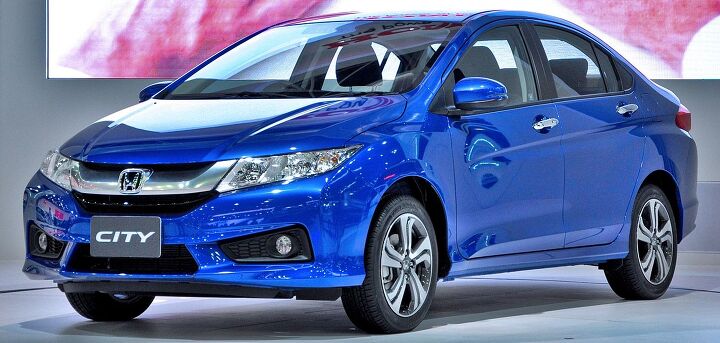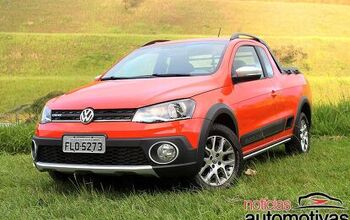Capsule Review: 2015 Honda City (Brazilian Market)

Cars do not exist in a vacuum. Besides all the regulations they must follow, there are market realities and competitors. Some makers are able to rise above the fray and charge more for their products as there is a perception that the cars are somehow superior to others, as is the case for many a German luxury maker. Others rely on their reputation of reliability and robustness to charge a bit more for their wares, such as most Japanese OEMs. In some markets though, it would seem makers overestimate their value and simply overcharge for what they deliver. Such is the case for Honda’s latest offering in Brazil: the Fit-based City sedan.
Costing from $22,000-$29,000, the Honda City has to compete with cars like the Ford Fiesta sedan and Fiat Linea, which costs thousands less. Sitting on the stretched version of the platform that underlies both it and the Fit, Honda stretched the 2015 City in all dimensions, too, except width. Therein lies this car’s problem. At just 66.5 inches in width due to Japanese regulations, the higher trim Cities are just not big enough to compete with larger Focuses, Sentras, Jettas, and various French models unknown in North America (and all are around 68 inches in width). Not only that, but content levels are lower, and dynamically speaking, it is also relatively inferior to the cheaper Linea and Fiesta. Cars like Renault Logan, Brazilian, Sonic-based, Chevy Cobalt or Nissan Versa come in cheaper, have similar driving dynamics and the same amount of interior space.
So how does Honda figure they can entice buyers to fork over more for less car? They added a CVT with seven virtual shift points and redid the exterior and interior design. The car has added chrome, and received more pronounced creases on the sides following its donor footsteps. Gazing at the car from the outside, I liked the new hood and the height of the car. The back now has elongated lights that help give the car an impression that it is wider, which would help in its quest to conquer higher prices. Not only that, the fact that those lights are mounted in a split fashion, helped Honda make the trunk opening wider and less of a hassle. It is now easier to make use of the 356L volume. Looking at the front though, I can’t help but feel overall this design is a step back; head on, it looks too much like Civics of old, though the three quarters look is quite dashing.
Stepping inside, the new improved dash is evident. Using the same shapes as those seen in the world Fit, the instrument cluster is different. It makes do without the deeply recessed binnacles the Fit uses, managing to look more refined. More expensive Cities light up in blue, while cheaper ones use red. Instrumentation, though still sparse, is more complete than on the outgoing model, giving the car an overall impression that it is now richer. On all but the basest Cities, air con buttons have been eliminated, giving way to digital controls that look good, but are harder to use. All Cities now also have a quite complete multimedia center, though it is smallish.
That positive impression does not last long. Even though everything is well assembled, plastics are nastier than in the Linea or the Brazil-only Chevrolet Cobalt (no relation to the North American car). The seats are a good size for its class (beating the Fiesta and Linea), but comparing to the larger cars it is still too hard and has excessive lumbar support. Longer than before, the two (ideally, since it’s a narrow bodied car) back passengers have more space for their legs and heads, though a fifth passenger would make life harder. The seating position for the driver is very good and everything has been perfectly aligned. Its relationship to the Fit is also felt here, as you sit high in this car, which is unusual for a Honda sedan.
Driving the car reinforces my suspicion that Honda is asking too much of the chassis, and the consumer’s wallet. It still uses the 1.5 engine, though output here is less than in other markets (115 horses). Honda skimped for Brazil and didn’t bump power up to the 130 ponies enjoyed elsewhere. However, it did increase the engine’s compression ratio, adding torque. Being lighter than the 1.8 and 2.0 cars it now competes with, top speed (around 190 km/h) and acceleration times (in the 12 second range) are very good and similar to the larger cars. One advantage it does have is economy, using less gasoline. Then again, a Brazilian Fiesta sedan uses even less.
A word must be said on the transmission. I drove the manual City as many changes have been made. Honda elongated fifth gear greatly aids this sedan. Now, higher speeds are reached at a more comfortable noise level. The engine is still a screamer with the manual, so much so that it becomes uncomfortable to try to explore its higher range, which is a shame. Honda claims it has added more sound insulation, but, in comparison to its rivals, tire roar and engine roar is still too much. The manual shifter is still a reference point for the competition to study. Very precise and light, it’s a joy to use. For aural comfort though, a buyer should choose the CVT equipped City. The driving experience is so much more refined that choosing the manual is only for hair shirt devotees of three pedals.
Using new bushings and hydraulic stops for the shock absorbers in the front, handling is comfortable, but precise. The back benefits from a more rigid, yet lighter, torsion beam, feeling more planted than before. Though it comes from the same family tree as the Fit, it behaves differently being softer and more comfortable. But the City likes perfect road surfaces. Over broken asphalt, it quickly becomes unsettled while even on good surfaces, that road is felt more than in competitors. The Fiesta is both more comfortable and takes curves better, while the Linea is more pliable (to say nothing of the bigger cars, more refined). Therefore, the City’s suspension setup limits make it a car that appeal more to a more conservative driving style and at a sedate pace it feels very relaxed and easy to live with.
Don’t get me wrong, this is a good car and will surely give owners many years of reliable service. Pressured from beneath by cars offering almost the same for less, and reaching up in price to compete with larger cars,, the Honda City is a tough sell. Being the pricing what it is, Honda should have endowed the car with more content and less noise. It would seem they are betting on its reputation of reliability. The market has accepted this proposition, but now Honda may be stretching it. As cars from other makers have become more reliable than ever, trading solely on reliability is very one-dimensional. Buyers looking for more have plenty of reasons to look elsewhere and the market, thankfully, provides many options to choose from.

More by Marcelo de Vasconcellos
Latest Car Reviews
Read moreLatest Product Reviews
Read moreRecent Comments
- ToolGuy Supercharger > Turbocharger. (Who said this? Me, because it is the Truth.)I have been thinking of obtaining a newer truck to save on fuel expenses, so this one might be perfect.
- Zerofoo Calling Fisker a "small automaker" is a stretch. Fisker designed the car - Magna actually builds the thing.It would be more accurate to call Fisker a design house.
- ToolGuy Real estate, like cars: One of the keys (and fairly easy to do) is to know which purchase NOT to make. Let's see: 0.43 acre lot within shouting distance of $3-4 million homes. You paid $21.8M in 2021, but want me to pay $35M now? No, thank you. (The buyer who got it for $8.5M in 2020, different story, maybe possibly.) [Property taxes plus insurance equals $35K per month? I'm out right there lol.] Point being, you can do better for that money. (At least the schools are good? Nope lol.)If I bought a car company, I would want to buy Honda. Because other automakers have to get up and go to work to make things happen, but Honda can just nap away because they have the Power of Dreams working for them. They can just rest easy and coast to greatness. Shhhh don't wake them. Also don't alert their customers lol.
- Kwik_Shift_Pro4X Much nicer vehicles to choose from for those coins.
- Jeff If this is sold in America at 90k it will be bolted to the dealer lots. If 60k to 90k ICE full size crew cab pickups are not selling as well this definitely will not sell. Also 90k for a KIa is ridiculous.


































Comments
Join the conversation
As usual, Great read Marcelo! Even though, as you mentioned, compared to Brazil pricing, the City is a bargain in Mexico, not many people have drunk the kool-aid. I rarely see them around here. They are never on any best seller lists either. Perhaps the higher maintenance costs, the Constant Velocity Trouble and parts availability have been its downfall. While we're on the topic here is a list of the top Mexican sellers as of Aug 8. 1. Aveo, perteneciente a General Motors, fue el auto más vendido con 29, 492 unidades. 2. Versa de Nissan logro colocarse en el segundo lugar con 22,642 ventas. 3. Tsuru también de Nissan, obtuvo 22,171 ventas. 4. Nuevo Jetta de Volkswagen, vendió 16,475 unidades. 5. Clásico 4 ptas tambien de VW logró 16,287 ventas. 6. Spark de GM, se vendieron 16,208 unidades de este subcompacto. 7. Vento de VW obtuvo un resultado de 16,192 ventas. 8. March de Nissan se colocó en el octavo lugar de ventas con un total de 14,156 unidades. 9. Sentra 2.0 de Nissan se vendieron 13,259 unidades. 10. Chasis Largo en décimo lugar este auto también perteneciente a Nissan vendió 12,023 unidades. Hmmmmmm not one Honda. Not even the newer, monster-sized (compared to most cars here) CRV. The dealership is right in front of our bank and looks to be a nice place to go meditate in total silence. Yikes!!!! what about that Tsuru Widow-Maker still at number 3???
Very interesting Marcelo. In India as well, the City is priced at a slight premium to 'C+ Segment' sedans.. Verna (Hyundai), Fiesta (Ford), Linea (Fiat), Ciaz (Suzuki), Vento (VW), Rapid (Skoda), Scala (Renault), Sunny (Nissan). It is in the $13000-$22000 bracket. Honda was one of the few manufacturers since 1998 to make sure that their lineup in India was in sync with the rest of the world. This was much appreciated. The '98-2002' Honda city was like a brilliant little Civic and many still dot the landscape. Despite the typical 'tinny' Japanese build, it was bullet proof - superb reliability, great MPG, years and years of trouble-free ownership. The new one, while it looks grotesque and gimmicky in my eyes, is being lapped up eagerly again and is the segment topper - a 'natural' choice of a middle class, 'I made it too' crowd. Spaciousness is much appreciated, and good cars like Linea and Fiesta, which have smaller interiors (who can touch Honda in this area..) just don't cut it. It also comes with a diesel mill for the first time ever - a 1.5 Earth Dreams diesel, which rejuvenated sales.